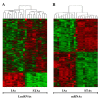Aberrant expression of lncRNAs and mRNAs in patients with intracranial aneurysm
- PMID: 27965470
- PMCID: PMC5356817
- DOI: 10.18632/oncotarget.13908
Aberrant expression of lncRNAs and mRNAs in patients with intracranial aneurysm
Abstract
Intracranial aneurysm (IA) is pathological dilatations of the cerebral artery and rupture of IAs can cause subarachnoid hemorrhage, which has a high ratio of fatality and morbidity. However, the pathogenesis of IAs remains unknown. We performed long noncoding RNA (lncRNA) and messenger RNA (mRNA) expression profiles in IA tissues and superficial temporal arteries (STAs). A total of 4129 differentially expressed lncRNAs and 2926 differentially expressed mRNAs were obtained from the microarrays (P < 0.05). Gene ontology (GO) and Kyoto Encyclopedia of Genes and Genomes (KEGG) pathway analyses showed that up-regulated mRNAs were enriched in immune response, inflammatory response, regulation of immune response and lysosome, et al; while the down-regulated mRNAs were enriched in muscle contraction, smooth muscle contraction, cGMP-PKG signaling pathway and vascular smooth muscle contraction, et al. The lncRNA-mRNA co-expression networks were represented in immune response, inflammatory response, muscle contraction and vascular smooth muscle contraction. These findings may gain insight in the pathogenesis of IAs and provide clues to find key roles for IA patients.
Keywords: gene ontology; intracranial aneurysm; long non-coding RNA; microarray; pathway analysis.
Conflict of interest statement
The authors declare no conflict of interest concerning the materials or methods used in this study or the findings specified in this paper.
Figures





Similar articles
-
Identification of a Long Noncoding RNA-Associated Competing Endogenous RNA Network in Intracranial Aneurysm.World Neurosurg. 2017 Jan;97:684-692.e4. doi: 10.1016/j.wneu.2016.10.016. Epub 2016 Oct 15. World Neurosurg. 2017. PMID: 27751926
-
Expression profile of long noncoding RNAs in human cerebral aneurysms: a microarray analysis.J Neurosurg. 2017 Nov;127(5):1055-1062. doi: 10.3171/2016.9.JNS16839. Epub 2016 Dec 23. J Neurosurg. 2017. PMID: 28009235
-
Exploring the association of long noncoding RNA expression profiles with intracranial aneurysms, based on sequencing and related bioinformatics analysis.BMC Med Genomics. 2020 Oct 6;13(1):147. doi: 10.1186/s12920-020-00805-x. BMC Med Genomics. 2020. PMID: 33023605 Free PMC article.
-
Non-coding RNAs role in intracranial aneurysm: General principles with focus on inflammation.Life Sci. 2021 Aug 1;278:119617. doi: 10.1016/j.lfs.2021.119617. Epub 2021 May 15. Life Sci. 2021. PMID: 34004250 Review.
-
Molecular mechanisms of the intracranial aneurysms and their association with the long noncoding ribonucleic acid ANRIL - A review of literature.Neurol India. 2017 Jul-Aug;65(4):718-728. doi: 10.4103/neuroindia.NI_1074_15. Neurol India. 2017. PMID: 28681739 Review.
Cited by
-
Multiomics integrated analysis and experimental validation identify TLR4 and ALOX5 as oxidative stress-related biomarkers in intracranial aneurysms.J Neuroinflammation. 2024 Sep 15;21(1):225. doi: 10.1186/s12974-024-03226-0. J Neuroinflammation. 2024. PMID: 39278904 Free PMC article.
-
Epigenetic mechanisms of neurodegenerative diseases and acute brain injury.Neurochem Int. 2020 Feb;133:104642. doi: 10.1016/j.neuint.2019.104642. Epub 2019 Dec 12. Neurochem Int. 2020. PMID: 31838024 Free PMC article. Review.
-
Characterization of Long Non-coding RNA Signatures of Intracranial Aneurysm in Circulating Whole Blood.Mol Diagn Ther. 2020 Dec;24(6):723-736. doi: 10.1007/s40291-020-00494-3. Mol Diagn Ther. 2020. PMID: 32939739
-
Identification of Hub Genes Associated with the Pathogenesis of Intracranial Aneurysm via Integrated Bioinformatics Analysis.Int J Gen Med. 2021 Jul 30;14:4039-4050. doi: 10.2147/IJGM.S320396. eCollection 2021. Int J Gen Med. 2021. PMID: 34354366 Free PMC article.
-
Epigenetic landscapes of intracranial aneurysm risk haplotypes implicate enhancer function of endothelial cells and fibroblasts in dysregulated gene expression.BMC Med Genomics. 2021 Jun 16;14(1):162. doi: 10.1186/s12920-021-01007-9. BMC Med Genomics. 2021. PMID: 34134708 Free PMC article.
References
-
- Krings T, Mandell DM, Kiehl TR, Geibprasert S, Tymianski M, Alvarez H, terBrugge KG, Hans FJ. Intracranial aneurysms: from vessel wall pathology to therapeutic approach. Nat Rev Neurol. 2011;7:547–559. - PubMed
-
- Vlak MH, Algra A, Brandenburg R, Rinkel GJ. Prevalence of unruptured intracranial aneurysms, with emphasis on sex, age, comorbidity, country, and time period: a systematic review and meta-analysis. Lancet Neurol. 2011;10:626–636. - PubMed
-
- Nieuwkamp DJ, Setz LE, Algra A, Linn FH, de Rooij NK, Rinkel GJ. Changes in case fatality of aneurysmal subarachnoid haemorrhage over time, according to age, sex, and region: a meta-analysis. Lancet Neurol. 2009;8:635–642. - PubMed
-
- Yan J, Hitomi T, Takenaka K, Kato M, Kobayashi H, Okuda H, Harada KH, Koizumi A. Genetic study of intracranial aneurysms. Stroke. 2015;46:620–626. - PubMed
MeSH terms
Substances
LinkOut - more resources
Full Text Sources
Other Literature Sources
Medical

